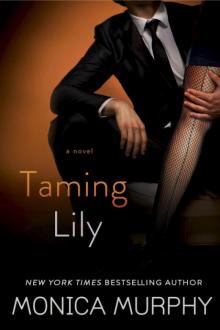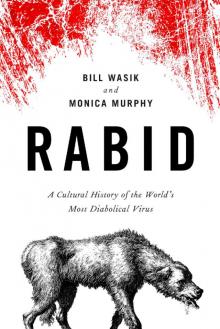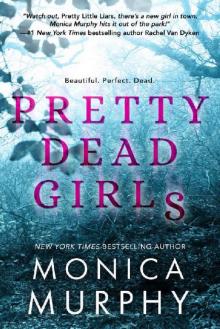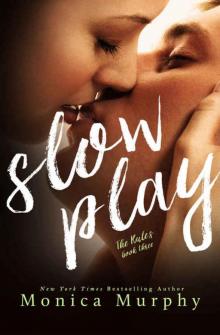- Home
- Monica Murphy
Rabid Page 10
Rabid Read online
Page 10
One can hardly blame Duff for failing to recover or remarry. His wife’s death in 1805 had left Edinburgh startled and not a small measure scandalized, as much for its peculiar beginnings as for its horrific conclusion. At some point during the previous year, four dogs of the Duff family had suffered bites from a rabid attacker. Three of these dogs belonged to the earl and were immediately put down. But the lady could not bear to lose her own lapdog, a French poodle named Pompey—a fitting allusion, it would seem, to unforeseen disaster. The creature was spared, but it proved to be a tragic pardon.
Many months later, the fateful symptoms began to appear in the lapdog and then, sometime later, in the lap’s owner. Rumor had it that to end her agonizing spasms, it was necessary to smother the splendid lady to death, though her doctors later insisted this had not been the case. Known to all as a dazzling beauty, Mrs. Duff was subsequently memorialized in a popular engraving, well trafficked for decades afterward, that showed the young lady stepping atop the crest of a globe, bearing aloft a sash and attended by cherubs whose presence connoted an ascent (as one admirer noted years after her death) to “another, and a better world.”
The precise mode of transmission remains disputed to this day. Soon after the event, the general opinion was that Pompey had nipped her on the tip of the nose. One Edinburgh wag, Charles Kirkpatrick Sharpe, quipped that “no nose was so much talked of since the days of Tristram’s Don Diego” and went on to describe the town’s general uproar:
Not a grain of rouge was left on a single cheek in E[dinburgh] with weeping; not one female tongue ceased talking of the catastrophe for a week. “Oh, she was such a sweet creature!” She had bought a whole cargo of silk stockings the day before she fell ill, and expected new liveries for her footmen every moment. Indeed, she had not one fault on the face of the earth. She was to have been at a ball the very night she died.
But later there seems to have been a consensus, developed among doctors, that the poodle was innocent of even a bite and that its friendly licks alone had spread the dreaded disease. An 1830 paper in the Lancet laid out this particular theory in detail. “She had a small pimple on her chin, of which she had rubbed off the top,” wrote William Lawrence, one of the journal’s founders; “and allowing the dog to indulge in its usual caresses, it licked this pimple, of which the surface was exposed.” Subsequent reports (perhaps following Lawrence) also specifically cited a pimple as having been the aperture to infection.
True or false, this invocation of unseemly acne on the fair Mrs. Duff’s visage also comported with the general disapproval, among nineteenth-century medical men, of the intimate canine congress to which lapdoggery led. The act of allowing a cur to lick a human face was, to their minds, the height of uncleanliness. “Not only a most disgusting, but a dangerous practice,” intoned one medical author, in discussing the Duff case; another called it “degrading” and “reprehensible” and went so far as to say, “I unequivocally condemn an indiscriminate attachment to, or imprudent fondling of dogs.”
In their scorn, these men of science were responding to a genuine sea change in the way pets, and in particular dogs, were regarded in the industrializing precincts of Europe and the United States. With the rise of a middle class, no longer tied to farms and their necessarily instrumental approach to animals, the treasured, pampered pet no longer figured as merely a luxury of the upper classes. In 1840s Paris, whose human population was just shy of a million, there were believed to be some 100,000 pet dogs. The nineteenth century saw the rise of dog shows (with more than three hundred held each year in England by century’s end) and “dog fancy” in general, a practice that could be joined even by those of modest means. Ever more citizens during the sweep of this century found themselves inclined to agree with Lord Byron’s epitaph for his beloved Newfoundland, Boatswain: “To mark a friend’s remains these stones arise; I never met but one—and here he lies.” (Boatswain expired from rabies in 1808, at which time Byron had him interred on the grounds of Newstead Abbey, the family’s ancestral home; three years later, Byron specified in his will that he be buried at Boatswain’s side, though this instruction was later countermanded.)
This transformation in pet-keeping was taking place at the same time that Europeans, with the increase in literacy and the explosion of the press, began to learn more about life in their ever-expanding colonies. Perhaps inevitably, the distinction between the familiar, domesticated pet and the ungovernable wild animal came to be seen as analogous to that between civilized and savage races. When Charles Darwin, in his 1868 treatise on domestication, remarked upon the tendency of half-bred animals to revert to a wild nature, he compared this to “the degraded state and savage disposition of crossed races of man” and approvingly quoted an assessment made to the famed Dr. Livingstone by a Zambezi native in Africa: “God made white men, and God made black men, but the Devil made half-castes.” With animals as with man, domestication and fine breeding were seen to bestow a moral as well as a physical fitness.
By insinuating itself into domestic tranquillity—by effecting the fall of Pompey, as it were—rabies presented itself as a shocking subversion of this order. As such, it became an object of disproportionate panic throughout the nineteenth century. Reports of allegedly mad dogs studded the newspapers. Stories of actual hydrophobic expiry were granted full columns stuffed with florid detail. Neighborhood councils formed to beat back the scourge of feral dogs, even as tuberculosis and cholera cut wide and far more fatal swaths through their same streets. As the historian Harriet Ritvo has pointed out, a person of that era (in England, at least) was ten times more likely to die of even murder than of rabies. But a death at the hand of man seemed far less horrible to contemplate than one suffered in the jaws of the devil.
Compounding the terror was the fact that science understood rabies little better at the start of the nineteenth century than it did at the end of the second. Good old Soranus of Ephesus, as handed down to us by Caelius Aurelianus, had a more sensible take on the causes and nature of hydrophobia than did many medical men of 1800. When Benjamin Rush, one of the United States’ most esteemed doctors and medical authors of revolutionary times, published his thoughts on the disease near the turn of the century, he began with a list of twenty-one supposed causes of hydrophobia, and the bite of a rabid animal did, mercifully, place first. But the balance of the list included “cold night air,” “eating beech nuts,” “a fall,” and “an involuntary association of ideas.” Seventeen centuries after Soranus and Sus´ruta had each succeeded in largely differentiating rabies from other maladies—not fully, to be sure, and not quite with rigor, but nevertheless judiciously—medicine was once again having difficulty in doing so.
Though a colonist, Rush was far from a rube by European medical standards. For his doctoral training he braved the ocean voyage to Edinburgh, whose university housed one of the late eighteenth century’s finest medical schools. There he was steeped in the teachings of the top European minds of the day, in particular Herman Boerhaave, the revered Dutch theorist who had died in 1738 but remained the towering figure in medical instruction throughout Europe. The chair of Edinburgh’s medical school was William Cullen, a world-renowned doctor and thinker in his own right, though his views diverged only slightly from Boerhaave’s. (On those instances when they did diverge, Cullen later recalled, he was immediately decried as “a whimsical innovator” whose apostasy would “hurt myself and the University also.”) Still influenced by Newton and his revolution in physics, these eighteenth-century doctors saw the body mechanistically, as a sort of hydraulic contraption of solids interacting with fluids, or “humors.” In their view, diseases often were corruptions of these humors, which could become overly acidic or alkaline. In assigning causes, the theory looked disproportionately to diet, reasoning that just as food could undergo insalubrious transformations outside the body, through spoilage and so on, it could also effect corruption on the inside.
From November to May, Rush imbibed these theories six da
ys a week, with almost no leisure time to speak of. The typical day involved studying all morning, then classes and hospital rounds in the afternoon, followed by still more reading until midnight. Edinburgh also schooled Rush in the experimental method. His chemistry teacher, Joseph Black, himself had used the occasion of his doctoral dissertation to prove the existence of carbon dioxide (or “fixed air,” as he called it), a result that opened the door to the discovery of oxygen. By comparison, Rush’s own dissertation, an inquiry into the acidity of the stomach during digestion, was rather less impressive in both methodology and results. “Having dined on beef, peas, and bread,” he wrote, “I puked up, about three hours afterwards, the contents of my stomach, by means of a grain of tartar emetic, and found them not only acid to the taste, but likewise that they afforded a red color, upon being mixed with the syrup of violets—an invariable mark this, of acidity, among chemists!”
Nevertheless, when Rush returned to America, he was appointed professor of chemistry by the College of Philadelphia. This made him, at twenty-three, the first chemistry professor in what was soon to become the United States. A staunch supporter of American nationhood, Rush eventually had the opportunity, as a member of Pennsylvania’s congressional delegation of 1776, to sign the Declaration of Independence, and during that tumultuous era he increasingly wedded his politics to his profession. After the Tea Act, Rush played upon his status as a noted physician to showily condemn tea itself, as having “mischievous effects on the nervous system,” and as the Revolution loomed, he applied his chemistry, too, penning three essays about how to make saltpeter—the crucial ingredient in gunpowder—from dried tobacco stalks; Congress later distributed these essays as a pamphlet, with an introduction by Ben Franklin. During the Second Continental Congress, Rush inoculated Patrick Henry against smallpox, and at Trenton, after George Washington’s famous crossing of the Delaware, Rush was on hand to perform battlefield medicine.*
Rush believed that rabies was, in essence, a “malignant state of fever.” In this opinion he was following a tradition, beginning at least with Boerhaave, that fever could be the immediate (though not always the root) cause of hydrophobia. Boerhaave attributed this fever to “inflammation,” a catchall concept in his mechanistic theory. Cullen, following this notion, developed the idea that such fevers were caused by “overstimulation” due to excess blood. The natural prescription, therefore, was bleeding, which is indeed what Rush advocates for the rabies sufferer. Rush’s main evidence for hydrophobia being an “inflammatory fever” is his observations of the blood, which, when drawn, exhibits both “size” (a term then for viscosity) and yellowness in its serum. He recalls that the blood “was uncommonly sizy in a boy of Mr. George Oakley whom I saw, and bled for the first time, on the fourth day of his disease, in the beginning of the year 1797. His pulse imparted to the fingers the same kind of quick and tense stroke which is common in an acute inflammatory fever.”
One of Rush’s medical students, James Mease, held a somewhat more accurate view—that hydrophobia was a disease of the nervous system—and, awkwardly for the two men, this view had seemingly been endorsed by Rush before the teacher later contradicted his pupil. Mease had laid out this theory in his 1792 doctoral thesis on the disease, which he had dedicated to Rush and for which Rush had even supplied a preface.† In 1801, chagrined to see that his old professor had now published a contrary opinion, Mease furiously produced a second pamphlet on rabies, this one explicitly addressed to Rush. Point by strenuous point he set out to rebut his former mentor. The woundedness of Mease’s tone as he did so (beginning with his florid prefatory note to Rush himself, telling the great physician that he has mistakenly returned to principles “previously destroyed by yourself”) was understandable given the personal connection between the two men. A family friend, Rush had known the young Mease since infancy and personally treated him through several serious childhood illnesses. “One of the first things I can remember,” Mease later recalled, was Rush “calling me ‘his boy,’ and he used frequently to say that I should be his apprentice.” This latter prediction, which Mease averred was “probably in jest,” was eventually realized when Mease enrolled for medical training at the College of Philadelphia.
In many respects, Mease’s gloss on rabies is hardly more helpful than Rush’s. He asserts that the illness can sometimes generate spontaneously in dogs, a widespread theory (as we will discuss later in this chapter) that seriously set back attempts to contain and control the disease. And by contemporary standards, his preferred treatment for hydrophobia—powdered jimsonweed—is every bit as daft as bleeding. But Mease does draw one very perceptive comparison that had eluded medical authors until then. Noting the irregularity of the onset of hydrophobia (the fact that the time between bite and symptoms is usually weeks, or as long as months) Mease realized that another illness involving puncture wounds behaves in a similarly odd way: namely, tetanus, or lockjaw. From what we know today, the two are different in many crucial respects: rabies is a virus, which travels up the nerve sheathings, whereas tetanus is a bacterium, with the chemical poison released by that bacterium, rather than the bacterium itself, journeying up the nerves. But rabies and tetanus are cousins, as it were, in that they are among the few pathogens whose malign effects spread along the nerves instead of the bloodstream, creating the strange phenomenon of a disease whose time of onset depends on the distance of the wound from the head.
Such minor flashes of insight aside, all these millennia of medical theorizing about rabies had yielded little usable knowledge. The reason for this, of course, is that medicine had yet to embrace the most crucial insight of all: the very existence of viruses and bacteria, agents of disease unseeable by the naked eye. At the time of Rush and Mease, science possessed neither the complex optics nor the practical wisdom required to make this leap. Less than a century later, seventeen centuries of stasis in our understanding of rabies would be obliterated—and largely by the dogged efforts and remarkable genius of a single man.
During one particularly bad rabies outbreak in England, the Liverpool Daily Post published a comical ditty, called “The Two Dog Shows,” that captured perfectly the stark dichotomy in the canine universe, between the increasingly cherished domestic and the increasingly terrifying feral. The poem began:
All London for the past few days, as you, of course, well know,
Has crowded Islington to see the Great Dog Show;
Which has been totally eclipsed by Liverpool: we find
They’ve had a dog show there for weeks of quite another kind,
One which is “open every day” in all the streets and lanes;
And which consist of tortured dogs, and dogs without their brains.
The nineteenth century was indeed the best and the worst of times for the Western dog, the most fortunate of which had finally been invited onto the foot of the bed, but the least fortunate of which met brutal ends in large numbers at the hands of exercised humans. In France, whose reputation as a locus of pet pampering was well deserved (one contemporary book on dogs stated, on its first page, “Le chien est une machine à aimer,” that is, “The dog is a love machine”), rabies fears in Paris led to “Great Dog Massacres,” sometimes called “canicides”—the tally in 1879 alone was 9,479 killed. In England, the preferred method of dispatch was beating the dogs to death with truncheons. Neil Pemberton and Michael Worboys, two University of Manchester historians who have studied the history of rabies in Britain, note that from the perspective of dog lovers, terror of the disease had “turned ordinary people into murderers.”
With little surety to be found in medicine, observers were left to formulate their own theories about which dogs should and should not be trusted. To some, domestication itself was seen as the enemy—“Constantinople and Africa are rabies-free,” it was often noted, erroneously—even as reports were coming in from India that the disease ran rampant among wild dogs and jackals. Some people believed that the best-kept dogs were the most dangerous—that too m
uch idleness, combined with overfeeding, predisposed them to the disease; that the inbreeding of purebred dogs “exhausted” their “nervous system” and made them susceptible. (As one correspondent remarked in the pages of what must be the best-titled publication in history, the Annals of Sporting and Fancy Gazette, “Hydrophobia makes its appearance…in dogs which exist in a state of confinement which are kept in towns and take little exercise.”) Different theories fingered different breeds as the primary culprits: retrievers, in one view; foxhounds, in another.
Most common of all, of course, was to blame the dogs of the lower classes. This was largely the view of animal-welfare advocates, who naturally believed that mistreated dogs, such as those made to pull carts (still a surprisingly common practice) or fight in rings, were the most susceptible. But in most people’s minds, it seemed clear that the degradation of the dogs was merely analogous to the degradation of their owners. One letter writer to the London Times remarked that these curs “infest our streets unmolested, creating noise, filth, and general annoyance; nor is this all, the peculiar sexual intercourse of the species renders them very dangerous. I have seen a whole gang of curs so strong excited, as to be little short of mad—so furious, indeed, as to change their very natures.” Wrote another correspondent to the Times, “If these no-breed curs, which are at least two hundred to one, were destroyed, there would be little fear of hydrophobia.” In the 1850s, France created its dog tax for the stated purpose of discouraging dog ownership among the poor. Britain had a similar tax, though it was levied only on dogs more than six months old, which wound up worsening the problem it aimed to fix: families would often acquire adorable puppies and then dump them on the streets, leaving them to grow up wild.
In the end, no dog could be trusted. Indeed, some experts cautioned that uncommon affection, of all things, could herald the onset of rabies. George Fleming, the British veterinarian whose 1872 treatise on hydrophobia was probably the definitive English-language survey in the pre-Pasteur era, warned against the “Judas’ kiss” of the rabid pet, explaining that

 Second Chance Boyfriend (Drew + Fable)
Second Chance Boyfriend (Drew + Fable) One Week Girlfriend
One Week Girlfriend The Junior (College Years Book 3)
The Junior (College Years Book 3) The Senior (College Years Book 4)
The Senior (College Years Book 4) The Freshman
The Freshman Meant To Be (The Callahans Book 4)
Meant To Be (The Callahans Book 4) Nothing Without You
Nothing Without You Thinking About You
Thinking About You Fake Date
Fake Date Her Defiant Heart
Her Defiant Heart Close to Me
Close to Me Holidate
Holidate Fair Game (The Rules Book 1)
Fair Game (The Rules Book 1) Addicted To Him
Addicted To Him Wedding Date (Dating Series Book 6)
Wedding Date (Dating Series Book 6) Damaged Hearts, Book 3
Damaged Hearts, Book 3 Never Let You Go (Never #2)
Never Let You Go (Never #2) One Night (Friends #0.5)
One Night (Friends #0.5) Never Tear Us Apart (Never Tear Us Apart #1)
Never Tear Us Apart (Never Tear Us Apart #1) Just Friends
Just Friends Drew + Fable Forever (Novella)
Drew + Fable Forever (Novella) His Wasted Heart
His Wasted Heart Three Broken Promises
Three Broken Promises Torn: A Billionaire Bachelors Club Novel
Torn: A Billionaire Bachelors Club Novel Her Defiant Heart - Monica Murphy
Her Defiant Heart - Monica Murphy More than Friends - Monica Murphy
More than Friends - Monica Murphy Taming Lily
Taming Lily His Reverie
His Reverie In The Dark
In The Dark Rabid
Rabid Saving It
Saving It Pretty Dead Girls
Pretty Dead Girls Daring the Bad Boy
Daring the Bad Boy Savor: A Billionaire Bachelors Club Novel
Savor: A Billionaire Bachelors Club Novel Four Years Later
Four Years Later Her Destiny
Her Destiny You Promised Me Forever
You Promised Me Forever The Sophomore
The Sophomore Damaged Hearts - Monica Murphy
Damaged Hearts - Monica Murphy Fair Game (The Rules #1)
Fair Game (The Rules #1) Crave
Crave Slow Play
Slow Play Blind Date (Dating Series Book 7)
Blind Date (Dating Series Book 7) Stealing Rose
Stealing Rose Forever: A Friends Novel
Forever: A Friends Novel Five Days Until You
Five Days Until You Safe Bet (The Rules #4)
Safe Bet (The Rules #4) Owning Violet
Owning Violet Intoxicated
Intoxicated